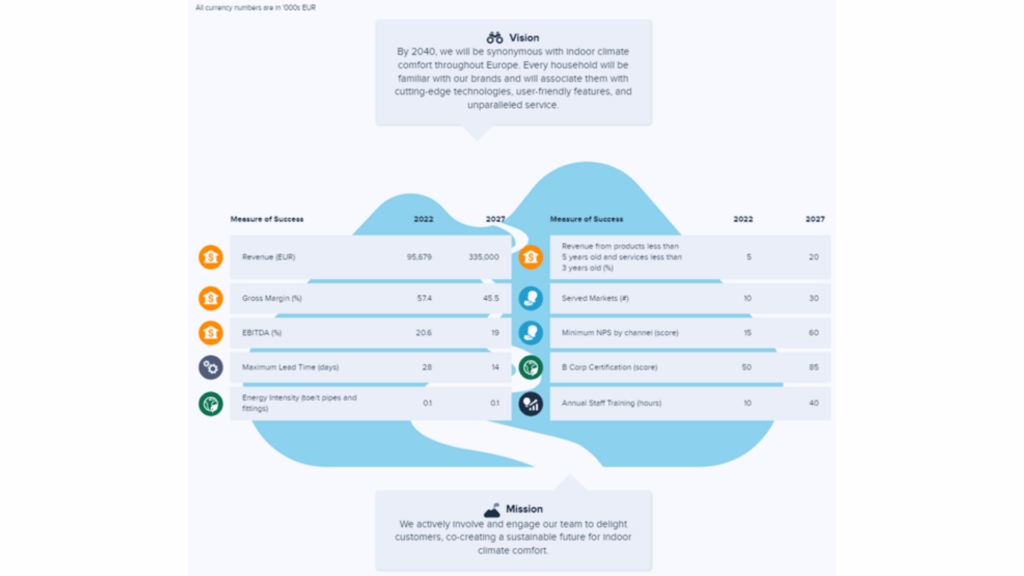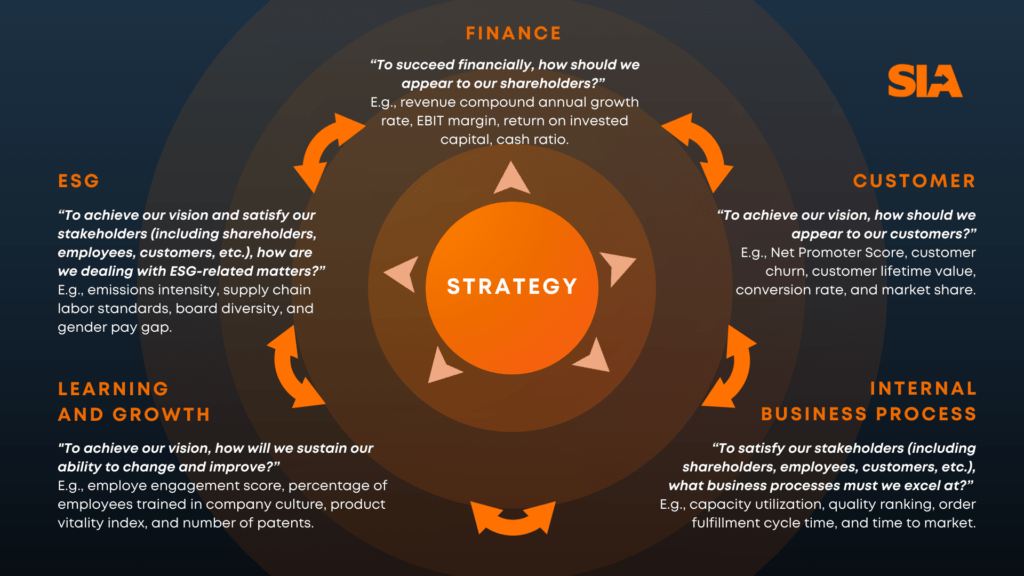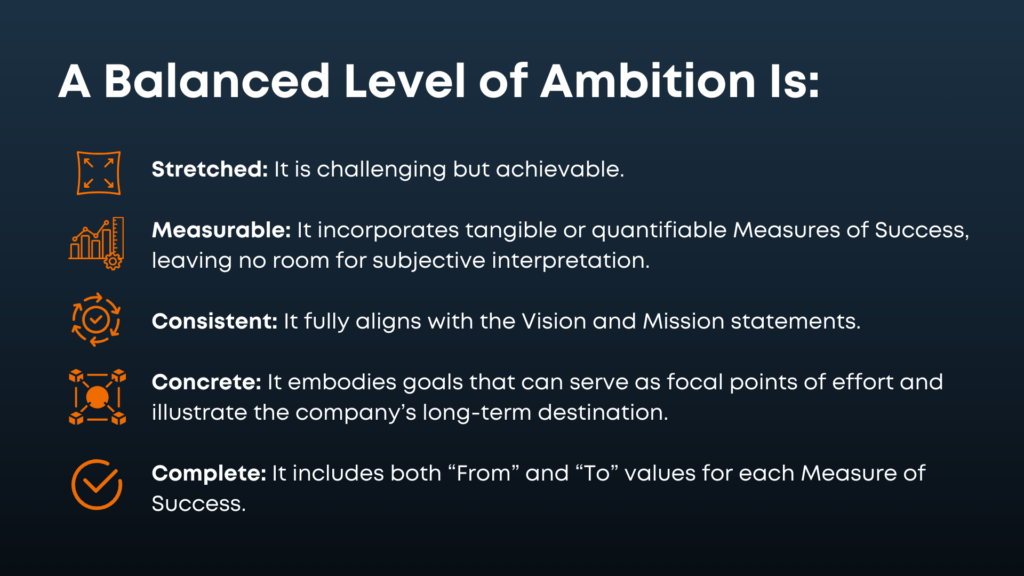
As discussed in a previous article, the initial decisions business leaders encounter in their strategy formulation journey revolve around defining their vision and mission statements.
However, since vision and mission statements are expressed in words, they can be subject to interpretation. Therefore, as the next step in their strategy formulation journey, business leaders are advised to complement vision and mission statements with the Level of Ambition.
Considering strategy as a journey that guides an organization from its current state to a new one, the vision can be likened to a postcard or picture of the destination to be reached. The mission represents the purpose, “the why” we embark on this journey, while the Level of Ambition is akin to the specific GPS coordinates guiding the path.
The Level of Ambition, in fact, translates the vision and mission statements into a set of Measures of Success, namely a set of measurable targets with clear “from” and “to” values. The “to” should be directionally correct but not overly precise; it should guide problem-solving rather than serve as an exact target. Because these targets are clearly defined and quantified, they facilitate the tracking of progress towards the desired vision in a practical and unambiguous manner.
Take Figure 1 as an example. A Measure of Success could be Revenue, which currently stands at €95,7 million. Based on the defined vision and mission statements, the company has determined that all actions taken during the five-year strategy period must result in an increase in revenue to €335 million. Thus, if at the end of the strategy period, the company’s revenue has indeed increased to at least €335 million, it means that the company has successfully achieved the ambition set forth by its vision and mission statements.

After defining robust vision and mission statements, the key task in translating these into the Level of Ambition is to identify the few Measures of Success that will effectively indicate that the company is progressing towards its vision while fulfilling its mission.
In order to identify relevant Measures of Success, a useful approach is to start by using the balanced scorecard, a strategic management framework meant to help organizations translate their vision and strategy into actionable objectives beyond just financial metrics. Developed by Robert S. Kaplan and David P. Norton in the early 1990s, the balanced scorecard in fact adopts four perspectives: Financial, Customer, Internal Business Process, and Learning and Growth.
The Financial perspective addresses the question: “To succeed financially, how should we appear to our shareholders?” This encompasses metrics such as revenue compound annual growth rate, EBIT margin, return on invested capital, and cash ratio.
The Customer perspective addresses the question: “To achieve our vision, how should we appear to our customers?” This encompasses metrics such as Net Promoter Score, customer churn, customer lifetime value, conversion rate, and market share.
The Internal Business Process perspective addresses the question: “To satisfy our stakeholders (including shareholders, employees, customers, etc.), what business processes must we excel at?” This comprises metrics such as capacity utilization, quality ranking, order fulfillment cycle time, and time to market.
The Learning and Growth perspective addresses the question: “To achieve our vision, how will we sustain our ability to change and improve?” This covers metrics such as employee engagement score, percentage of employees trained in company culture, product vitality index, and number of patents.[i]
Furthermore, in recent years, there has been a significant surge in interest concerning matters related to ESG (Environmental, Social, and Governance), driven by the increasing demand from both investors and the general public for enhanced transparency and socially responsible management practices from companies. Several studies have indicated that integrating ESG impact measures into the core of an organization’s strategy can help sustain its competitive advantage.[ii]
Therefore, ESG metrics could be considered a fifth additional perspective answering the question, “To achieve our vision and satisfy our stakeholders (including shareholders, employees, customers, etc.), how are we dealing with ESG-related matters?” This comprises metrics such as emissions intensity, supply chain labor standards, board diversity, and gender pay gap.
All Measures of Success should be articulated in a clear and unambiguous manner, detailing precisely what they track and how they are calculated. This ensures that employees can immediately understand their significance and relevance to the organization’s ambition.

Once the Measures of Success have been selected and defined, the next step consists of establishing the “from” and “to” values, namely the starting point of the organization and the ambition it intends to reach.
Ambition in strategy involves setting goals that stretch the organization’s capabilities and drive it to deliver exceptional results. Stretch goals are designed to push teams beyond their perceived limits, leading them to think outside the box and develop creative solutions. While they should be achievable, they require exceptional effort, dedication, collaboration, and a growth mindset.
The key to effective stretch goals is balance—they should be challenging enough to inspire, but not so unrealistic that they lead to frustration or burnout. They must always be calculated and grounded in a deep understanding of the company’s strengths and weaknesses, market opportunities, and competitive landscape.
Moreover, when defining the desired ambition, it is important to consider whether the company already has the necessary resources—people, capital, technology—to support its ambitious goals or if consideration should be given to making them available. Realistically assessing available and potentially available resources is essential for success.

An ambitious strategy requires a clear understanding of where the company currently stands, where it wants to go, and what it will take to make that leap. Strong leadership is needed to guide the organization toward achieving those ambitious goals and objectives. This involves adopting effective communication systems to ensure that everyone is aligned and committed to reaching them.
A powerful tool for ensuring effective communication is the “Strategy in a Page,” a document that consolidates the company’s Vision, Mission, and Level of Ambition all on a single page. Figure 1 illustrates an example of the Strategy in a Page document.
Once prominently displayed across the organization, the Strategy in a Page becomes instantly accessible to everyone. Whether it’s executives, managers, or frontline employees, the Strategy in a Page ensures that everyone can quickly grasp, with a single glance, the overarching direction and objectives of the company. This fosters alignment and clarity of purpose across the entire workforce in a concise and effective manner, enabling every team and individual to understand how their work contributes to the company’s long-term success.
It is important to note that while having an ambitious strategy is important, so is the ability to adapt to changing circumstances. The Strategy in a Page should be flexible enough to accommodate shifts in the market or within the organization while still maintaining ambition high. If the business environment changes significantly, a revision of the Strategy in a Page is necessary.
By setting ambitious goals and aligning your organization with them, you can foster a culture of excellence, attract top talent, and set the stage for significant growth and innovation. Remember, the Level of Ambition you incorporate into your Strategy in a Page can determine the heights your organization can reach. Aim high, plan strategically, and prepare to surpass even your own expectations.
[i] Robert S. Kaplan and David P. Norton, The Balanced Scorecard: Translating Strategy into Action (Boston, Massachusetts: Harvard Business School Press, 1996).
Robert S. Kaplan and David P. Norton, “The Balanced Scorecard—Measures that Drive Performance,” Harvard Business Review, January–February 1992, https://hbr.org/1992/01/the-balanced-scorecard-measures-that-drive-performance-2, accessed May 2024.
Robert S. Kaplan and David P. Norton, “Using the Balanced Scorecard as a Strategic Management System,” Harvard Business Review, July–August 2007, https://hbr.org/2007/07/using-the-balanced-scorecard-as-a-strategic-management-system, accessed May 2024.
Davide Sola and Jérôme Couturier, How to Think Strategically: Your Roadmap to Innovation and Results (Harlow, England; New York: Pearson, 2014).
[ii] Robert G. Eccles, Ioannis Ioannou, and George Serafeim, “The Impact of Corporate Sustainability on Organizational Processes and Performance,” Management Science, Volume 60, Issue 11, pp. 2835-2857, February 2014, available at http://dx.doi.org/10.2139/ssrn.1964011, accessed May 2024.
Witold Henisz, Tim Koller, and Robin Nuttall, “Five ways that ESG creates value,” McKinsey & Company, McKinsey Quarterly November 2019, https://www.mckinsey.com/~/media/McKinsey/ Business%20Functions/Strategy%20and%20Corporate%20Finance/Our%20Insights/Five%20ways%20that%20ESG%20creates%20value/Five-ways-that-ESG-creates-value.ashx, accessed May 2024.